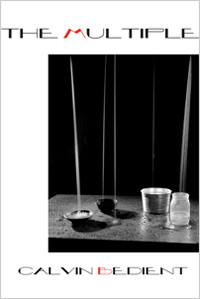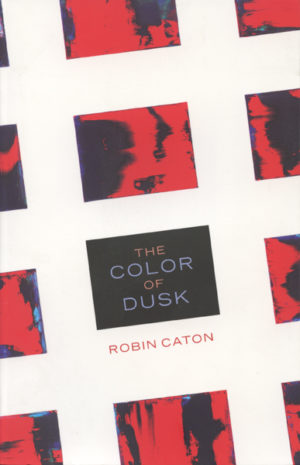Description
Mortar is a text of stealth and volatility, of both explosive and empathic interactions. Just as the title connotes both the short smoothbore gun used by the military to wreak havoc, and the organic material made from cement, sand, lime and water that bonds the bricks of a cityscape together, so, too, do these poems offer both the emergency of society’s destructive failings and the sometimes vexed sometimes confoundingly transformative emergence of intimacy between self and other. The fragments that construct these poems court grammar and turn from it, their slipperiness befits both the anxiety and ambivalence—the pleasure and the trap—of attempting to name the known, the knowable, and then to find oneself snared in the constructs that such knowing compels one to inhabit. Uneasy, vigilantly aware of the mire of awareness, these poems wrest from daily encounters of city life a contentious consciousness that can open, albeit explosively to each next instant.
Sara Mumolo’s Mortar strips the “flexible architecture of belonging” of its democratic sentimentality. By examining the ideology of their own careful phrasing, her poems reveal and revel in what it means for a citizen to belong simultaneously to a plurality of subject positions and symbolic systems. The surreal intersections of gender, nation, class, language and genre become, in her work, “an activity/not an image,” a subversive motile language that dares to “disarm the most comfortable beliefs” and critique “how the bourgeoisie believed in Desire.” With wry feminist humor and not a little ambivalence, her poems document the psychic costs of an economy that conflates sex and capital, the female nude and the courtesan. “Rolling over onto backs, we’re conflict’s mascot,” Mumolo bravely writes, “none of these anxieties are new.” Dear wise and foolish virgins of late, late capitalism: this book is for you.
Brian Teare, author of Companion Grasses
Sara Mumolo’s MORTAR is a book of action and reflection, of succinct dramatic moments. Forgetting and remembering, the saint of translation, “St Jerome climbs out of his pictures.” The easy, lilting physical and metaphysical figures radiate a painterly, storybook quality that messes with the concision of Mumolo’s diction, her unexpected puns. In MORTAR, the “fragile achievements of uncertainty” – the certainty of uncertainty – is imagined amidst the natural world and worlds of human construction, the “bouquets of buildings.” This book is a clarifying encounter.
Norma Cole, author of To Be At Music
Remember the Athens, Georgia band Pylon? If not, that’s okay—they’re kind of timeless and you can Google them, though we should also be careful not to equate the quality of a thing with how easy it is to access. As you’ll hear, Sara Mumolo has some of that band’s jittery energy and something like their sound, which is to say the anxious, odd, and increasingly common sound of personal electronic devices rendering our insides almost entirely public. Remember when blogs were the old new guitars? But true to its name and in the faces of its crises, Mortar keeps it together.
Graham Foust, author of A Mouth in California
About the Author
Reviews
Excerpt
Sara Mumolo is the Program Manager for the MFA Program in Creative Writing at Saint Mary’s College of CA. She co-edits CALAVERAS, an irregular chapbook series, with Alisa Heinzman. Her first collection of poems, Mortar, will be published by Omnidawn in fall 2013 and her chapbook March was published by Cannibal Books in 2011. She created and curated the Studio One Reading Series from 2008-2012. Some poems appear in Action Yes, 1913: a journal of forms, Coconut, Lana Turner Volta, and Volt, among others.
A brief interview with Sara Mumolo
(conducted by Rusty Morrison)
It is such a delight to be interviewing you because your first book coming out with Omnidawn! You have been one of Omnidawn’s longest tenured and most important poetry editors. And, it’s especially meaningful to me that I was an early reader for much of this work, since you were in my workshop at Saint Mary’s College when I was a visiting writer there. You were such a terrific student, I had to invite you to be an intern with us. What a thrill it is for me to see this book come to fruition! That it became a finalist, selected by Fanny Howe, for the 1913 Poetry Award, made it clear to us that we simply had to ask you to let us publish it. Can you say a bit about the work? What is at the core of this material for you?
Working with you at Saint Mary’s and Omnidawn has changed not only my poetry community, but it also augmented my sense of what’s important to a poem/poetry. I feel most invested in work that is culpable, that has something at stake in the world. It’s an honor to be a part of this press and feel the immense support of that kind of work.
The use of fragment and phrase in the first half of the book seems antithetical to the second half’s fuller sentences and lines; these formal constraints are the work’s bones. The fragments both imply grammar and belie it, causing logical cause and effect to be slippery, a gesture that befits the anxiety and ambivalence of embodiment. There is a sense of vulnerability when approaching questions about embodiment and how this relates to the other, to community, to place. The sentences that form the second half of the book do something similar in a dissimilar way when they take the more massive moment, the grammatically correct and point to the faultiness in this seemingly logical way of thinking, of composition.
So many of the poems in Mortar reflect such a strong relationship to place and to community—at times inviting, and at times demanding that the reader inhabit, and examine, these experiences with you. The other element that feels so compelling to me is the relationship to an intimate other. Can you talk about these three deeply significant forces, these magnetic fields that draw our attention?
One way the concepts of “community and place” operate in Mortar is as a community of place. I wanted to discern how people make a community when they are bound together in a place for a continuous amount of time (work, residence, etc). Sometimes these places are results of choices we make and other times they are consequences, such as the workplace. The community we forge there, and how we participate in it—these are the forces in Money on It, the second half of the book. One of the questions I was thinking about when writing that longer sequence was how we interact with the intimate other in a larger group, a community. What is the intimate other’s role in a mob? Each individual, once he or she identifies with the crowd, helps to construe the mob or the community, making it into an entity, helping to determine how it will evolve as an “other.” Even going to a stadium to watch a game activates role-related identities that we step into because we are in this different place, interacting with that specific community. These personal connections we feel toward our environments, those dimensions of self, can define our relationships to community. Connections often result from submerged patterns of ideas and values that create our behaviors as individuals, but also contribute to how the community acts and is perceived as a whole—the spirit of the place or its genius loci.
Would you talk about the relation of the title to the text?
Mortar is used to bind construction blocks or brick together; this substance embodies the physicality of community in the work. It’s a workable, manipulated material that when set becomes fixed. Mortar recalls the insertion of place in the poems, but in this recollection it carries the destructive connotation of the relatively simple weapon by the same name.
In braiding these together, masonry and weaponry, I thought to compliment the dissonance in the poems and nod at vexed relationships in the book between self and other, self and community/community and self, self and place (the cityscape, the home, the sea, west coast backdrops). This discord is also somewhat at work in the cover image. I hope a sense of emergency or a sense of something being “at stake” as a result of the pressure among these motifs and themes is present in the poems.
Manuscripts often undergo revision before reaching their published form. Would you discuss your relationship to revision? Which poem or poems were the first that you wrote? How did the collection change as you continued to work with the material? Which series in the book was most challenging to you to bring to completion? Which most surprised you?
Writing happens through revision. Or, I should say that I don’t differentiate between writing and revision. I hand-write lines and rewrite these lines repeatedly before they reach the computer screen. I tell myself that it’s hard to rewrite an empty line by hand. Since writing and revision happen in tandem on the poem/series level, revision becomes more sculptural at the manuscript level. Figuring out how to sculpt the series of poems into a book manuscript was particularly challenging. I thank Rusty for advising me throughout this process.
Once I knew which poems should survive the transition from paper to screen, my relationship to revising the manuscript changed. This is probably more of what people think of as editing. Seeing the poems together in manuscript form changed my perception of the work, as I began to see a two-section book, rather than many series of poems present within in the two sections. I became interested in how these two sections could aggravate and augment each other.
The second section of Mortar seemed the most complicated to revise, as its ambitions of address were more vast, massive even. The speaker of the first section enters into the long sequence of the second section by submerging itself in the “we,” but by employing the first person titles, the individual voice also asserts its presence. Of course, this challenge was also what made it fun to write. I could imagine the eclipse of the self in the vast places that “Money on It” employs, a stadium, a park—gathering locales in a community or city. I wanted to tease the positive and subversive aspects of what a collective sense of community or those markers of place undergo in reaction to late capitalism, the spectacle that we find ourselves at risk of employing.
Thinking about all these ideas in relation to the series of Nudes in the book helped me to see the poems that I’d been writing for years reach a formative whole. There’s a surprising sense of fear in realizing the whole and then a mourning once it’s been formed, but there’s also a sense of elation in the fact that writers have the sheer will to make these books and put them into the world to contend with that world.
Who are the authors with whom you feel a kinship? Who most influenced Mortar? Who are you reading currently?
What I’m reading currently doesn’t really correspond to what I was reading when I wrote the poems in Mortar. I was became interested in texts by poets on subjects of visual art or other mediums. When writing the poems I was reading a lot of T.J Clark (Farewell to an Idea, Sight of Death), John Ashbery’s Reported Sightings: Art Chronicles, Barbara Guest, as well as Blanchot’s The Space of Literature.
I thought of Blanchot’s text almost as a handbook. It still goes with me when I travel and has that loved/used look where the sides are curled and the pages are marked. Another poet that I feel a deep kinship with among that group is Barbara Guest. Her art criticism and prose were large influences, such as Forces of Imagination. My collection of her books and the Blanchot handbook always live near my desk. It’s also good to say in this space that visual art played a role in Mortar’s poem making like Nan Goldin’s depiction of community in her Ballads, Jenny Saville’s Nudes, and Hiroshi Sugiomoto’s patience in the minimalist Seascapes. Sugiomoto’s seascapes reminded me of Agnes Martin’s drawings, both of which seem interested in depicting time. Martin said she paints “with her back to the world.” I sometimes wish this were true about poetry, that we could forget our poems the way Martin can forget a painting when it walks out the door. Poets read our work to a public, and so our work’s interaction with the world forces not only the work to contend with it, but the poet to contend with it as well. I hope the poems in Mortar depict a care for that world, even if that care is nonspecific, it stems out of these influences.
In my bag right now: the reader from the class Michael Palmer recently taught at Saint Mary’s on poets writing prose, Etel Adnan’s Sea and Fog, two of my friends’ amazing new books: Jane Gregory’s My Enemies and Lynn Xu’s Debts and Lessons.
Would you tell me a bit about yourself? Anything you are willing to share that might not be in your short bio that is published in the book?
I moved to the Bay Area in 2004 where I received my BA in English from the University of California, Berkeley and my MFA in Creative Writing at Saint Mary’s College of CA.
A few years later, I’m now the Program Manager for the MFA Program in Creative Writing at Saint Mary’s, managing the daily operations of the program and focusing on its development over time. It’s a brief description for a busy job.
With my friend, Alisa Heinzman, I co-edit the chapbook series, Calaveras, a journal based out of Oakland, California and Lincoln, Nebraska. Alisa and I met while in the MFA Program at Saint Mary’s. She’s an editor at Octopus Books, and I like that together we bring such aesthetic-varying writers into one space. Calaveras is really a project entertained by the chapbook as a piece of design work itself. Alisa’s husband Jake Gillespie helps us to make our lofty visions for design into beautiful objects.
Before meeting Rusty at Saint Mary’s and starting my relationship with Omnidawn, I created and curated the Studio One Reading Series in Oakland, CA. I started the series in the summer of 2007 and ran it with co-curators and volunteers until 2012. Recently, I passed it on to another Saint Mary’s alumna, and the series is thriving, which is really satisfying—to see such endeavors continue after my tenure. In addition to the reading series, I helped to create and run the successful Afterschool Arts Program for K-6th graders at Studio One, which is still giving the children of Oakland a place to make art. Studio One Art Center is Oakland’s only city-run art center. In a city with a deeply embedded thrust for community art, this seems like a shame. I was happy to contribute what I could to the accessibility of art and poetry while I was there. The center makes art classes accessible to both children and adults, as it’s subsidized by the city, so the fees are actually fair and affordable. Class participants don’t have to pay to keep the lights on in the building. The reading series was always free and donation based. It creates a space where all are welcome to enjoy poems by local and national writers on the first Friday of every month.
In 2011 Cannibal Books published the chapbook, March. Just a few of these March poems ended up in Mortar. Some other poems in the manuscript have appeared in 1913: a journal of forms, Action Yes, Coconut, Lana Turner, Eleven Eleven, The Offending Adam, Real Poetik, The Volta, Volt and West Wind Review, among others.
You chose the image that is used in the cover design for this book. Would you be willing to describe your reasons for this choice? Anything you’d like to share about the process of making that choice?
The process for making the choice seemed by chance. My partner Alberto and I were going through my grandmother’s 17-volume set of Time Life Library of Photography that came out in the ’70s and Alberto stumbled across this photograph, which is cropped for the cover. He held it up and said, “Look at this! Could this be it?”
The original photograph feels more massive than the cover and has an interesting border of the city on both sides of the wall, which appears on the rear cover of the book. When you look at the rear side of the cover, you get a glimpse of this cityscape, of what might be a park or apartments in an indeterminable state, eclipsed by the sharp, diagonal edge of the wall. This sharp line meets the wall’s base, which frames the bottom of the image and the front cover with an uneasy line. The composition pits this inconsistent line against the sharp edges of the wall with what we assume to be the ever-expanding cityscape just beyond the camera’s frame.
These compositional choices along with the bleakness of the massive wall led me to choose the photograph. The set concrete of the wall is heavily textured, so that it almost looks like the sea. It’s beautiful, but also stark and severe in its presentation. I find myself interested in artwork, writing, or theory that is almost complete in its form and presentation of ideas that it’s also almost its opposite, as if it can step through the mirror. Although the focus of the photograph is the wall, not the boy eclipsed (like the cityscape) by his headwear, he enlivens the image, vying for focus against the massive textures. I think this photograph could resemble a place in the book.
Before getting too deep into Mortar, Sara Mumolo’s first poetry collection, you run into a familiar yet disarming question: what am I doing here? The trick to reading Mumolo’s book is to wait for her to answer that question for you. She explores individuals and groups, how one belongs to and behaves in each of those identities, from an art class drawing a nude to someone crying in an airport food court. In the poem “I can’t hide you—the rock cried out” she writes: “Variety is the plastic we make invisible, industry / is everything, even gardenias.” She responds to “industry” here, and throughout her book, as both a machine-like thing and a process as natural and productive as flowering plants. Mumolo and her speaker take care of the reader throughout like guardians: while I feel detachment and even dissonance reading Mortar, I never feel totally alone.
Plasticity is a critical term for this collection. Plasticity, from the Greek, plassein: to mold, in this case the poet is molding, modeling, and creating bonds between disparate elements. A plastic mortar, of sorts, is brought to use that not only binds, but disrupts present relations and combinations, as it gives and lends itself to movement and recombination of elements and various modes of articulated human experience. In Mortar, all combinations, then, are plastic, so too are divisions that exist between sense, intellect, and the various micro-facets of lyricism that are brought in and out of relation in the formulation of a self – a lyric self.
The poems sparkle with the observations of a self-aware speaker who is both public and private. The book in its entirety solves the postmodern dilemma of how to be an individual while constructing new realities and fresh perceptions. These poems are bright and original without being self-indulgent. Mumolo sings of our multi-faceted humanity in simple phrases that bite and sting so adroitly that we are moved to a new level of consciousness about the world we inhabit together.
This nude is planetary, heavy. Also, “what does the moon do” [the moon so often allied with the feminine] begs us to answer the question it poses. If I remember correctly from elementary school science classes, the moon reflects (light). Reflections make me think of mirrors, which do not show us what we really look like, but rather switch our left and right sides. [Hence, those of us with asymmetrical faces look slightly different in a mirror than we do in a photograph.] And yet despite this reflection, this illusion, we continue stubbornly as we are. “BOOMING,” if you will. Mumolo’s nude is claiming something back for herself. As a whole, these nudes reject their own commoditization even as they wonder just how possible it is to step out of the frame. The effect is eerie, ethereal.
Upon close examination, I notice these blank moments in almost everything Mumolo writes. Often they arrive quietly, as unspoken connections or linguistic unravelings. Lines fall off into silence or fray into wordplay like “break the blank” or “Last glass of champagne before your lie.” The book’s heartbeat seems to be a continual exploration and affirmation of these blank spaces, lifting them up, acknowledging and examining them from all sides, as dimensional and active.
DECENTRALIZATION OF EASEMENT
Maybe she’s as lonely as the rest of us, not comfortable with failure.
I step into your voice, its outfit. I watch you wear your voice. You
could say I cultivated a face. In your. Makeup. I’ve packed up all the
weather. Men having babies in their paintings. Babies history arrests
outside of my museum, which is her museum. I sing into its building,
unharvested with echo. Tone on sleeve. She’s as lonely as the rest of us,
she says. And wears it, disdainfully. I put my cheek on the frame to cool
my eyes. You say you’re writing this one as a woman comfortable with
failure. I am breathing this one as a failure comforting her. She writes
this uncomfortable movement. This one has a body to zip up. This one
is a reel around the baby. A bird’s wingspan in a museum, its echo on
my tear.




